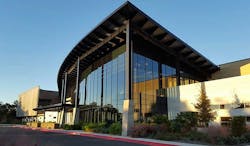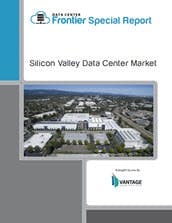CyrusOne will build a data center campus in Santa Clara, bringing a new player into one of the nation’s most active markets. The expansion continues a push by CyrusOne to add customer capacity on the West Coast to broaden its national footprint.
As the leading data center hub in Silicon Valley, Santa Clara is home to 34 data centers in a three-and-a-half square mile area, rivaling “Data Center Alley” in Northern Virginia for the world’s largest concentration of data centers. It is a key strategic market for the industry’s leading players, housing major campuses for Digital Realty, DuPont Fabros Technology, CoreSite Realty, Vantage Data Centers, QTS Data Centers and many others.
“We’ll be entering that market soon,” said Kevin Timmons, Chief Technology Officer for CyrusOne. “We think we’re going to do really well in that market. There’s no significant capacity there now.”
Details on the location and size of the new campus will follow soon, said Timmons, who said CyrusOne has been actively scouting properties for months in Santa Clara, where open land is in short supply and data center companies are moving to secure space for future expansion.
“The hunt for properties has been the challenging part,” said Timmons. “That’s largely complete.”
Filling A Gap in its Footprint
CyrusOne has been building a national network of data centers, but has no facilities west of Phoenix. Addressing that gap in its portfolio has been one of the company’s goals for this year. In May CyrusOne announced plans to expand into the Pacific Northwest, acquiring land in Quincy, Washington where it will soon begin construction on a data center campus. The other missing piece was Silicon Valley.
Silicon Valley is one of largest and most important data center markets in the U.S., providing space to deploy new hardware and services from the Valley’s marquee technology companies and startups. The region is home to nearly 2.6 million square feet of data center space, according to market research from datacenterHawk. That makes Silicon Valley the second-largest market for data center space in the U.S., trailing only Northern Virginia. Santa Clara has emerged as the data center capital of Silicon Valley due to competitive power pricing from the municipal utility, Silicon Valley Power.
Over the past year, CyrusOne has emerged as the leading growth story among real estate investment trusts (REITs) specializing in data center development. The company’s ability to deploy new capacity quickly has won CyrusOne a succession of large leases with leading players in cloud computing.
The CyrusOne San Antonio I data center. (Photo: Rich Miller)
CyrusOne has also demonstrated the potential to be a disruptive player when it enters new markets. In later 2014 the company entered Northern Virginia, probably the nation’s most competitive data center market.
In two years, CyrusOne has built and leased two buildings -including a 30-megawatt data center for a major cloud provider that was completed in just six months – and has begun work on a third data center that is also fully pre-leased. The company recently acquired 40 acres of land to build a second campus in Sterling.
Supply and Demand in the Valley
As we recently noted in our special report on the Silicon Valley market, data center developers are applying the lessons of history as they enter a new phase of expansion, seeking to balance strong demand from hyperscale Internet companies against the risk of overbuilding.
The current demand for space is strong, as reflected in the vacancy rate of just 8.2 percent in the region. The wholesale data center market is very tight, with several operators working to deliver capacity.
Data Center Frontier Special Report: The Silicon Valley Data Center Market. Download It Now.
Several recent deals have seen new supply leased up before it is built, prompting new construction announcements. Over the past several years, providers in the Silicon Valley market have been cautious about new construction and disciplined in their deployment of capital, building space in smaller increments. At the close of the second quarter, there was 28 MW of capacity under construction in Silicon Valley, compared to 12.25 MW in the first quarter of 2016, according to datacenterHawk.
Although this number has doubled, construction volume in Silicon Valley trails far behind other major U.S. data center markets. Northern Virginia, Dallas/Fort Worth and Chicago all have in excess of 100 MWs of capacity currently under construction.
Several companies have started construction projects to bring additional capacity online. These include:
- Vantage recently announced plans to build two new data centers on its Santa Clara campus. The first building, known as V6, is scheduled to come online next year. The total buildout for the two properties will be 21 MW. In addition, Vantage has secured land for a second major data center campus in Santa Clara, which is planned to house an additional 51 MW of IT capacity, with the first building likely to come online in 2018.
- Equinix has broken ground on SV10, a new data center on its South San Jose campus that will be built in three phases, offering 14 MW of capacity at completion. Equinix has plans to build another facility (SV11) on the property as SV10 nears capacity.
- INFOMART has just announced a 6 MW expansion of its campus in San Jose (formerly Fortune Data Centers). The company will retrofit an existing building, and has land available for additional expansion.
- CoreSite has just opened SV7 in Santa Clara, which brings 230,000 SF of space online. The facility is 62 percent leased, reflecting the strong demand for space in Silicon Valley.
Absorption Rate Supports Expansion
The CyrusOne project will bring additional new supply onto the market. Timmons said the current demand justifies the investment, and that market risk will be offset by CyrusOne’s ability to deliver capacity on tight timelines
“We stayed out of that market when everything was so iffy,” said Timmons. “But the absorption rate in that market is now quite good. I’m excited about both Santa Clara and Quincy.”
Timmons was an early believer in the Quincy market, building data center projects there for both Yahoo and Microsoft. He said it offers the best economics anywhere for operating a hyperscale data center.
“The trend in this industry is going to push us into lower-cost markets,” said Timmons. “They’re going to be the heart of Internet infrastructure.”
For more on the Silicon Valley market, we invite you to download the Data Center Frontier Special Report: The Silicon Valley Data Center Market.
About the Author




